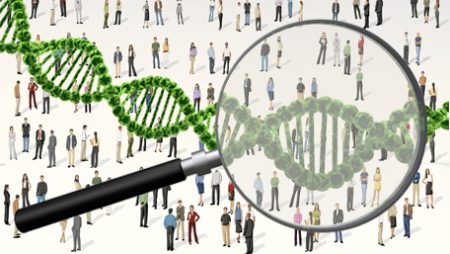November 22, 2017 – The technology behind genetically modified organisms (GMOs) is often associated with images of a “Frankensteinian” world where we humans have taken on powers that in some minds should only be unleashed by a Creator or Nature itself. Since the Neolithic Revolution, some 10,000 years or more ago, humanity has been manipulating plants and animals in an effort to secure adequate food supplies. For 9,980 of those years or so, we confined our efforts to plants and animals with favorable character traits which we then selectively bred, altering their genomes. This “tried and true” approach to creating GMOs was seen as not superseding our human authority as genetic engineers. It’s only when we invented means to alter the DNA of plants and animals to create character traits of value to humanity that many humans proclaimed we had crossed a “line in the sand.” The anti-GMO movement was borne and the spreading of the “Frankenfood” myth began.
In two of this week’s headlines the myth of “Frankenfoods” persists. But despite the resistance, our third headline shows the momentum in the marketplace globally for GMO products.
Canadian Supermarket Chains Reject GMO Salmon
I have written about genetically modified Atlantic Salmon in past postings. Known as the AquAdvantage Fish, this salmon incorporates Pacific Chinook Salmon genes and a genetic switch from a fish called the Ocean Pout. In November of 2015, it received U.S. FDA approval for human consumption. Last summer it was declared safe in Canada. But that isn’t stopping an anti-GMO group, the Canadian Biotechnology Action Network (CBAN), from raising opposition to the sale of this farmed fish in supermarkets.
The latest to join a group of retailers is Sobeys with a network of 1,500 stores across Canada. it joins Loblaws and Metro, and together all three represent better than 50% of Canada’s food retailers. CBAN’s objections to the fish are related to the lack of GMO labeling. They have also conducted a poll back in 2015 before the salmon was approved for human consumption and state that at the time 45% of Canadian consumers would not eat a GMO fish.
The company has responded stating that in test kitchens consumers readily accepted their GMO fish and further stated: “We are disappointed that groups continue to misrepresent and disparage our product, and attempt to prevent consumers from deciding for themselves what products to purchase.”
Further compounding the efforts of the company to get the product into the North American market, the FDA which initially approved the GMO salmon for human consumption, subsequently banned its import until the U.S. Congress passed legislation to approve the sale of this GMO and other GMO products.
AquAdvantage is not some Frankenstein monster. It is a product of technological innovation that takes the next step from modifying genes through selective breeding to modifying them by manipulating the genome using 21st-century tools.
It needs to be reiterated. No one has ever gotten sick from eating any GMO foods whether plant or animal. The resistance by groups like CBAN is purely emotional with no scientific foundation.
Anti-GMO Movement Accused of Manipulating Consumers Emotionally
In an article appearing in Forbes this week entitled, The Anti-GMO Movement Has A Social Justice Problem, author Kavin Senapathy writes that GMO “is a social justice issue,” that it “can help alleviate nutrition and food security problems in the developing world.” But even armed with this knowledge it is hard to resist the anti-GMO movement which plays on inner fears and consumer ignorance.
Senapathy questions labeling that states a product’s content contains no GMO ingredients. She argues that these labels tell us “absolutely nothing meaningful…including healthfulness, environmental impact, and working conditions for food workers and farmers.” She goes on to state that the labeling doesn’t even inform consumers as to the “objection” related to GMO content.
But it is in this paragraph where she hits the nail on the head when she writes, “GMO is practically impossible to define, at least in a logical way. Nearly every single plant and animal humans consume have had their genes (which contain the DNA molecules that code for each organism’s structures and functions) altered well beyond nature’s jurisdiction.” The truth is we are all consumers of GMO foods because from the dawn of the Neolithic Revolution we have been manipulating plant and animal genes, altering the natural DNA in everything we grow and eat.
In a paper written by Brandon McFadden and Jayson Lusk, Department of Food and Resource Economics, University of Florida, they found out that 80% of Americans when polled wanted to see DNA labeling on all food.
Think about what this says about consumer understanding of what is food.
Other than salt, some spices, and a few oils, everything we humans consume contains DNA.
What this says is there is a gap between what science publishes and what the public knows in the field of GMO, and this gap is even larger than the one that confuses consumers in separating weather from the science of climate change.
Why is this?
Because consumers are being manipulated by fear and by interest groups with a hate-on for large monopolistic companies like Monsanto and its new parent Bayer, who initially pioneered the work on GMO in an effort to help farmers improve yields and fight off weed, fungal and insect infestations plaguing their crops.
Senapathy points out that GMO bananas may save us from a global crop failure caused by Banana Xanthomonas Wilt, (BXW) a bacterial disease. By adding a pepper gene to the banana plant BXW can be stopped. But that hasn’t stopped the anti-GMO protestors from trying to block propagation of this selective breeding advance obtained through the direct manipulation of the banana plant genome.

The same is true about golden rice, a GMO food containing added Vitamin A, and developed by NGOs to end childhood blindness, a common scourge in South Asian countries.
But the anti-GMO movement ignores the relevance of these technological advancements by exploiting fear, uncertainty, and doubt (FUD) using the “Frankenfood” buzzword. The real objection remains hidden. What anti-GMOers don’t like is that many of the GMO foods developed are patented by the biotechnology companies that developed them. It is these patents that raise ire in the anti-GMO crowd. So it’s not about healthy food or safe food. Instead, it’s about intellectual property sensitivity.
Senapathy’s article is far more pointed in its criticism than what I have stated here, and well worth a read if you are one among many who are still sitting on the fence when it comes to accepting the science of GMO foods.
GMO Market to Grow to $6.28 Billion US by 2022
The latest market research looking at the impact of CRISPR, TALEN, ZFN, and cell line engineering in animals and plants indicates that the current GMO global market valued at $3.19 billion will almost double in the next five years. The reasons given:
- government funding of the research,
- private enterprise developing more genomic projects,
- the prevalence of infectious diseases and cancers that are seen as likely candidates to target with GMO solutions,
- the advancements in the science of genomics including the technology and tools,
- the proven impact of GMO crops in farming data,
- and the growing number of applications where genomics is seen as appropriate in tackling human challenges.
For GMO, genetic engineering, and genomics, this cumulative annual growth rate at better than 14.5% over the forecasted period may seem low when you consider the almost weekly headlines about the latest CRISPR/Cas9 discoveries. But, nonetheless, it is encouraging because it shows that despite anti-GMO biases persisting in the consumer marketplace, the pursuit of the science and the benefits derived are pushing back against the general ignorance.
If those in the field of GMO science want to win the hearts and minds of the public, it is the stories coming out on cures of diseases through precision medicine using genomics that will have the greatest impact. Then maybe the public will begin to understand that the cures applied to suffering humans, can also produce food solutions that will be equally impactful on a growing global population facing the uncertainty of climate change.

















